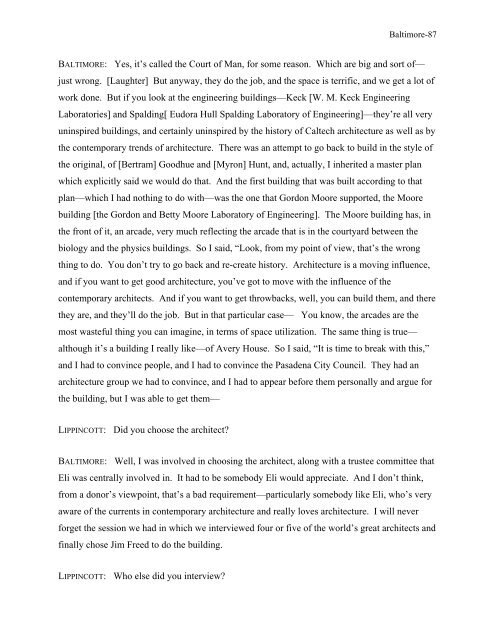Interview with David Baltimore - Caltech Oral Histories
Interview with David Baltimore - Caltech Oral Histories
Interview with David Baltimore - Caltech Oral Histories
Create successful ePaper yourself
Turn your PDF publications into a flip-book with our unique Google optimized e-Paper software.
<strong>Baltimore</strong>-87<br />
BALTIMORE: Yes, it’s called the Court of Man, for some reason. Which are big and sort of—<br />
just wrong. [Laughter] But anyway, they do the job, and the space is terrific, and we get a lot of<br />
work done. But if you look at the engineering buildings—Keck [W. M. Keck Engineering<br />
Laboratories] and Spalding[ Eudora Hull Spalding Laboratory of Engineering]—they’re all very<br />
uninspired buildings, and certainly uninspired by the history of <strong>Caltech</strong> architecture as well as by<br />
the contemporary trends of architecture. There was an attempt to go back to build in the style of<br />
the original, of [Bertram] Goodhue and [Myron] Hunt, and, actually, I inherited a master plan<br />
which explicitly said we would do that. And the first building that was built according to that<br />
plan—which I had nothing to do <strong>with</strong>—was the one that Gordon Moore supported, the Moore<br />
building [the Gordon and Betty Moore Laboratory of Engineering]. The Moore building has, in<br />
the front of it, an arcade, very much reflecting the arcade that is in the courtyard between the<br />
biology and the physics buildings. So I said, “Look, from my point of view, that’s the wrong<br />
thing to do. You don’t try to go back and re-create history. Architecture is a moving influence,<br />
and if you want to get good architecture, you’ve got to move <strong>with</strong> the influence of the<br />
contemporary architects. And if you want to get throwbacks, well, you can build them, and there<br />
they are, and they’ll do the job. But in that particular case— You know, the arcades are the<br />
most wasteful thing you can imagine, in terms of space utilization. The same thing is true—<br />
although it’s a building I really like—of Avery House. So I said, “It is time to break <strong>with</strong> this,”<br />
and I had to convince people, and I had to convince the Pasadena City Council. They had an<br />
architecture group we had to convince, and I had to appear before them personally and argue for<br />
the building, but I was able to get them—<br />
LIPPINCOTT: Did you choose the architect<br />
BALTIMORE: Well, I was involved in choosing the architect, along <strong>with</strong> a trustee committee that<br />
Eli was centrally involved in. It had to be somebody Eli would appreciate. And I don’t think,<br />
from a donor’s viewpoint, that’s a bad requirement—particularly somebody like Eli, who’s very<br />
aware of the currents in contemporary architecture and really loves architecture. I will never<br />
forget the session we had in which we interviewed four or five of the world’s great architects and<br />
finally chose Jim Freed to do the building.<br />
LIPPINCOTT: Who else did you interview

















